[ad_1]

Stuart Klipper, Derelict drive-in theatre, Darwin, Minnesota, 2010.
COURTESY THE ARTIST
Taking Place
“In another generation I could be sitting around looking at the Talmud and studying the subject from many different angles,” explained photographer Stuart Klipper. Instead, the Bronx-born, and since 1970, Minneapolis-based photographer has taken on an equally fastidious but far broader purview: he has focused his lens on the likes of Antarctica, Greenland, Iceland, Svalbard, Alaska, and Lapland (the area irradiated by the Chernobyl disaster), as well as the deserts of Israel and Sinai, the tropical rain forests of Costa Rica, Northern Australia, Patagonia, Tierra del Fuego, Sri Lanka, and Pakistan . . . just for starters. He has also photographed the Anasazi ruins of the Southwest. The vastness of the perspectives and the monochromatic quality of his settings allow ample space and time for creative imaginings.
Klipper captured a derelict drive-in theater in Litchfield, Minnesota, in 2010 that looks like an elegant deconstructed modernist play area rather than an open-air dump, and he has photographed the cemeteries of World War I and memorials of the Western Front. This is not Trump’s America.
“I can’t imagine not focusing on America,” Klipper acknowledged. “I get out in the cold, and when I’m there, I see what I can find. I was adopted by cultural geographers a while back,” he said. “I hope to find something in the regions I explore. At the same time, I have my own idiosyncratic interests.” He elaborated, “I like to stop and look out into wide-open distances. I like to look at fields. I’m interested in the nature of place and placement in nature. With a camera,” he pointed out, “you’ve turned what you see into a place.”

Stuart Klipper, Palm Grove, RR Yard, Riverside, CA, 1996.
COURTESY THE ARTIST
One of Klipper’s series is “Palm Grove, RR Yard, Riverside, CA., 1996.” He writes, “In doing it, I’ve scoped out the lay of the land and ‘the hand of man’—and what may have been wrought in places where the two overlay.”
The image is utterly charming—lots of palm trees beside the train cars, some looking stately, others slightly potbellied.
“I was building up a metaphorical and cognitive structure,” he said, adding, “a lot of my information comes from literary and movie sources.” It’s hard not to think of big Western movies looking into the far distance, as in the quietly dramatic Road to Bonneville Raceway, Great Salt Flats, Utah, from the 1990 series “The World in a Few States,” and at old disused towns populated by artifacts, like the Litchfield, Minnesota, drive-in.

Stuart Klipper, Road to Bonneville Raceway, Great Salt Flats, Utah, 1990.
COURTESY THE ARTIST
Klipper gets ideas for subjects in many ways. Some are incidental; others come from friends who suggest sites. “I get calls from certain parts of the country where they’re relevant. And, I’m not always alone. My partner, Kathleen Richert, who is a plein-air watercolorist—will point out things that she knows I’m interested in as we’re driving along,” Klipper added.
“People have spoken of the effect of some of my photos this way,” Klipper said. “It’s like the sense that ‘I’m not from this place, but if I were from it, this is how I’d describe it.’ ”
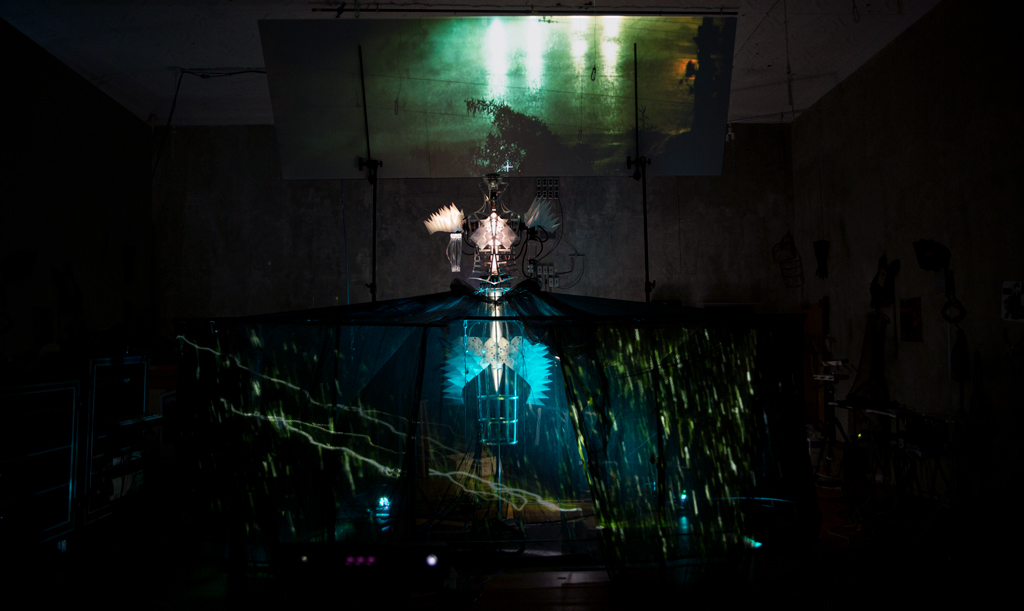
Toni Dove, The Dress that Eats Souls, 2017, installation view.
COURTESY THE ARTIST AND THE RINGLING MUSEUM OF ART
Ghost in the Machine
You have entered into a system of projections devising a character, in the form of a frightening skeletal corset and an ephemeral, billowing dress awaiting inhabitation. A disembodied voice utters instructions and is quick to reprimand if they are not followed. “Raise your right arm—no, no, not all the way, stand in the middle, look up and then down a bit.” Gradually, you find yourself activating the dress and filling that ghostly presence. As you shift your head, you become aware of those who have entered before you, tracking their eye and body movements, and thereby putting the character in history and time.
The Dress that Eats Souls (2017) is the centerpiece of the exhibition “Toni Dove: Embodied Machines,” commissioned by the John and Mable Ringling Museum of Art in Sarasota, Florida, and running there from February 25 through May 20. As the viewer stands in a pool of light in a dark room a massive robotic dress appears projected in various guises, depending on the viewer’s vantage point. The dress seems to come to life, activated by the observer’s own motions, and it begins to tell a story.
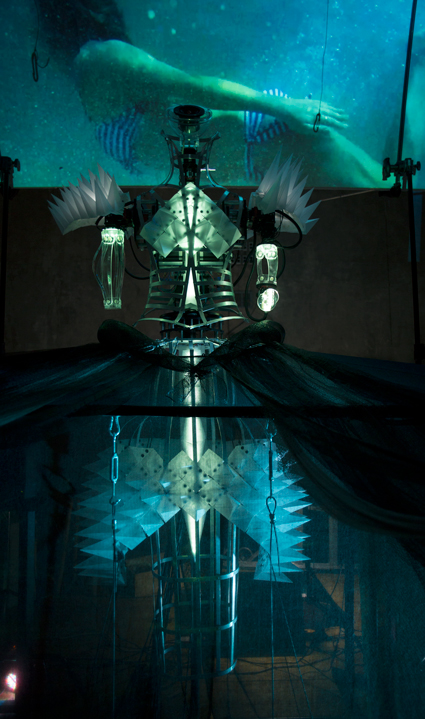
Toni Dove, The Dress that Eats Souls, 2017, installation view.
COURTESY THE ARTIST AND THE RINGLING MUSEUM OF ART
The exhibition’s curator, Matthew McLendon, currently director of the Fralin Museum of Art at the University of Virginia, and until recently, curator of modern and contemporary art at the Ringling Museum of Art, described multimedia experimental artist Toni Dove as “a pioneer of digital media and mixed-media reality; she operates this 21st-century studio system (like Rubens’s workshop). She demands that tech catch up with her vision. She’s doing it in service to narrative.”
Dove, he said, introduces the real world into the virtual one. “Through your body or Dove’s you have an effect on the narrative,” McLendon explained. “Tech is tracking our corporeal reality—the body becomes part of our technical reality. Through built environments, the work describes the space you’re interacting with,” he said.
Dove has a novelistic bent, while, as McLendon has pointed out, “at her core, she’s a filmmaker.” She imbues her works with the magic of Henry James, evoking his ghost story “The Jolly Corner,” for example; his apparitions inhabit the psychic rooms of her sculptures, and, at the other end of the spectrum, there’s a bare-bones Samuel Beckett quality to the repetitive instructions and their deadpan tonality and affectlessness. This keeps us on edge, not knowing when we’ll be reprimanded and who is doing so.
Design and craft interact with art in the exhibition, as do many elements of Dove’s previous installations. This work grew out of her last piece, she noted, a performance involving 3D robotics, costume design, and LED technology. “I’d always wanted to do a version of Lucid Possession as a fully automated piece, and then I realized I’d already done it with the Dress. . . For the new piece, an installation, I looked at 200 years of technology’s impact on the human body.” All the while, Dove said, “I have also been concerned with consumer culture, with fashion, materials, and with our endless desires and adaptation to new technology, from bitcoins to virtual reality. It’s all about shifting perspectives.”
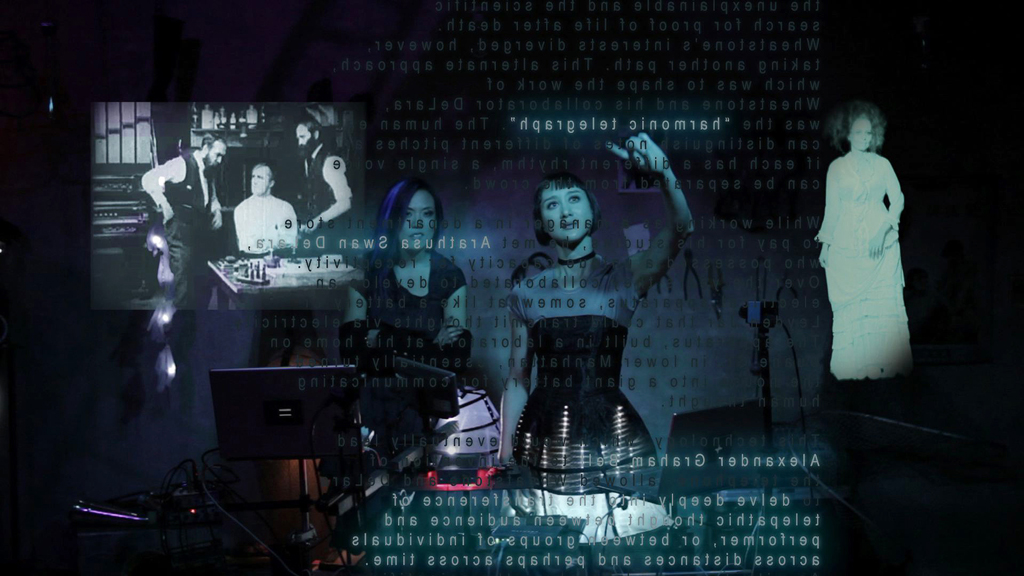
Toni Dove, Lucid Possession (still), 2013.
COURTESY THE ARTIST AND THE RINGLING MUSEUM OF ART
Painting came first for Dove, who is the granddaughter of the modernist painter Arthur Dove. She began her career as a painter before she discovered her own artistic space. “I was more of a collagist,” she said, “combining abstraction infrastructure with imagery. So in a sense my aesthetic just evolved into time and light and three dimensions.”
The legacy from her grandfather, she said, is that she is an experimenter—he experimented with collage and hand-mixed paints, and she, with technology and less tangible matter, including performance and interactive narrative.
There are also other works in the show including Artificial Changelings (1998), in which a kleptomaniac in 19th-century Paris dreams of a 21st-century hacker; Spectropia (2001), a sci-fi film noir involving a machine that creates virtual realities and Lucid Possession (2013), a musical thriller that features live music and robotic projection screens, from the point of view of a programmer, her avatar, and their real and virtual community of fans. (Accompanying the exhibition will be live performances on April 13 and April 14, 2018.)
McLendon referred to Dove as having “a steam-punk esthetic” together with a touch of the “Victorian sublime.” The work combines film noir and sci-fi in scenarios that take us through time and space, with an ambiguous but overarching narrative that evolves with our own participation and our interaction with on-screen avatars. In all the conversations surrounding virtual space and meatspace, what could be more relevant?
Filling Up With Gass
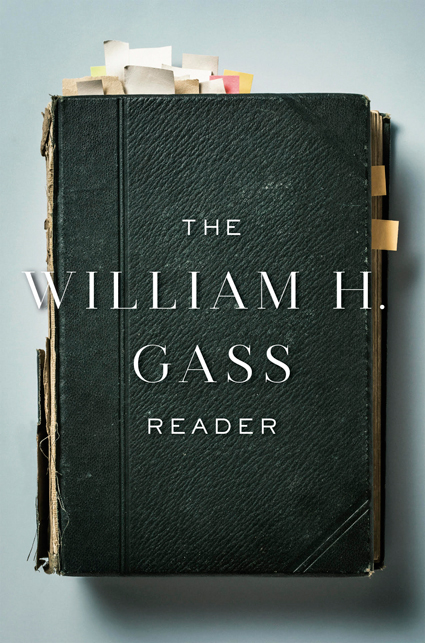
©KNOPF
Constructing a solid building—or even a garden plot—with words is hardly an easy task. The mortar and hardware must reside in the reader’s imagination as must the unruly weeds and leggy plants. However, in his recent omnibus collection, novelist, poet, philosopher, and intellectual maverick William Gass creates such structures and ground plans as elegant and effective habitations for words and ideas.
A huge compendium, The William H. Gass Reader is in effect a giant, boundless collage that includes more than 50 pieces—essays, criticism, and fiction, with subjects ranging from Plato to Henry James to Gertrude Stein to the Apocalypse Museum and with Gass’s reflections on art, architecture, music, and of course literature, all woven together in a tight, witty, and sometimes bawdy tapestry. In a chapter titled “The Architecture of the Sentence: Essay and Drawings,” Gass begins by defining spaces—“the ones in which we live and work and build in” and “those places in the head or on paper where we imagine relations and try to express them. . . . Here in such spaces, we think we plan and we design.”
The chapter is filled with diagrams, charts, schematic pictures and a characteristically breathtaking range of allusions and associations. Gass asks, for example, what is the relation between an engraver’s perspective and an actual street, “between the Social Register and a cardboard house beneath a bridge? Between a note and a noise?” His ultimate point is: you need ways—“representational” spaces—in which to think about and convey these ideas.
Most literally, in a sense, there is Concrete Poetry—words and picture in one. They are inseparable. He puts the word-poems through their grammatical paces. The Concrete Poem is what it looks like and says it is. A poem, an object, a connection, and of course, an idea of an idea. And then there is the rhythm of it all and how that rhythm looks.
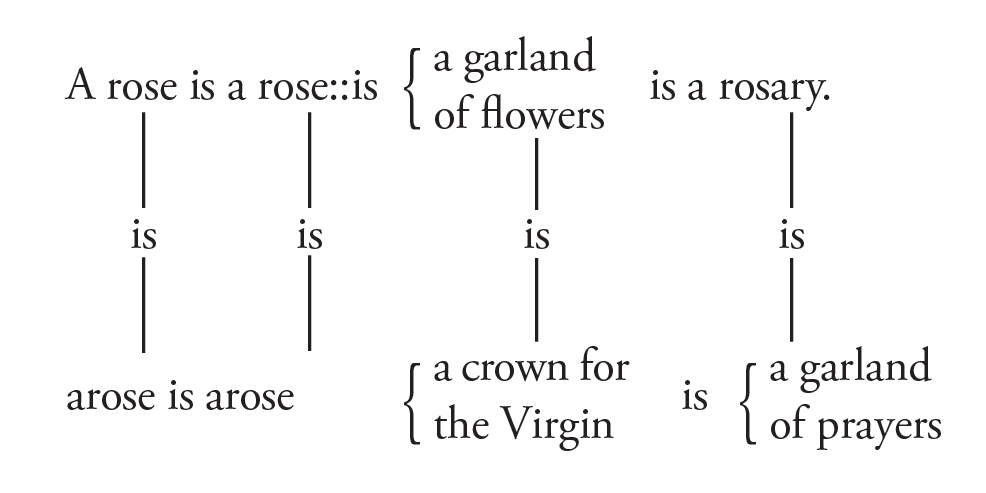
A word-picture from The William H. Gass Reader.
©KNOPF
In another chapter, “Rilke’s Rodin,” Gass relates how Rilke approaches Rodin in 1902 to write about him and his work. Rilke had begun portraying the sculptor in advance and then after meeting him, wrote to his wife, Clara, “I found him Smaller, and yet more noble. That forehead, the relationship it bears to his nose which rides out of it like a ship out of harbor . . . that is very remarkable.”
In the chapter “Gertrude Stein and the Geography of the Sentence,” Gass puts the word-pictures (shown here) through subtle paces, writing, “These chaplets retain the plainest syntax, but beneath the simple grammar of these buttons lie meanings which have nearly lost their syntactical value becoming astonishingly plastic.”
In the visual and verbal and rhythmic arts, it’s the spaces in between that shape meaning and perceptions and give them a place to preside, shape, and disrupt and add to the entire edifice the weight of emptiness—a solid binder.
[ad_2]
Source link

